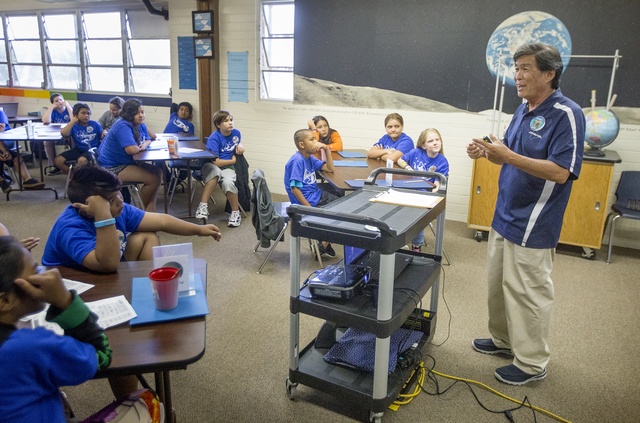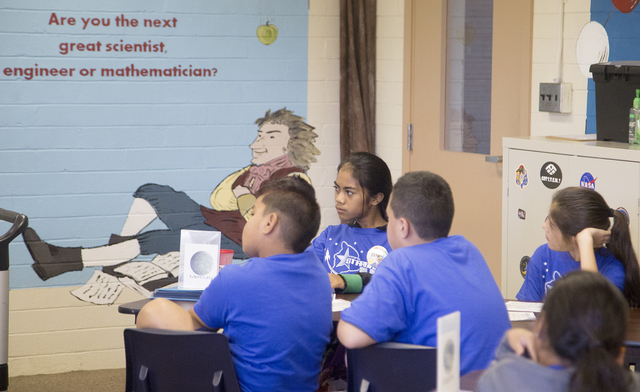About two dozen Keonepoko Elementary School students were all ears Tuesday as they learned: How far away is lightning when a storm hits?
“When you see lightning, count ‘one, two, three, four, five,’” instructor Dennis Taniguchi said to the room of fixated young eyes, explaining thunder claps five seconds later indicate lightning about 5,000 feet away. “Tall poles, tall trees — if you see a lone tree in the middle of the field, stay way. That’s where lightning is going to be attracted to.”
It was a lesson on the states of matter, one of several the Keaau-based STARBASE Hawaii program features during its five-day excursions aimed at making science, technology, engineering and math more fun. The program hosts the excursions throughout the year.
Later in the week, the kids will take part in three-dimensional printing, bottle rocket construction and other STEM activities.
“I think it’s interesting,” said 11-year-old Luke Seebruch, one of the Keonepoko students, adding someday he wants to become an engineer. “I like to design and build and solve problems. (As an engineer) you can solve any problem in the world.”
Keaau’s STARBASE site, housed in what used to be the National Guard armory, is one of 59 throughout the country, all sponsored by the U.S. Department of Defense. The program targets disadvantaged youth in rural areas or inner cities and exposes them to STEM fields.
The Keaau site started in 2008 and now serves more than 600 students each year. On April 22, the site is hosting a special ceremony in celebration of graduating 5,000 students.
“We’ve kind of become this mainstay for the community,” Program Director Todd Friel said during a recent tour. “They don’t want us to leave. We’re this resource, where our teachers (cannot always be). For example, if teachers get a $200 allowance for science in the school year, we know that’s not enough to provide the type of hands-on activities that should go along with (science).”
The program, a mix of lectures and hands-on material during the five-day period, targets fifth-graders, which officials say is a pivotal grade level in a student’s learning trajectory.
Each site is sponsored by a military branch — Keaau’s is sponsored by the Hawaii Air National Guard. STARBASE once featured a site on Oahu at Pearl Harbor, which closed in 2013 because of sequestration cuts, Friel said.
Officials say the need in East Hawaii is great. Every school in the state Department of Education’s Ka‘u-Keaau-Pahoa complex — the primary complex the Keaau site feeds from — is considered a Title I school, meaning it receives federal funding set aside for schools with a high number of low-income students. Every school in the complex also has at least 76 percent of students eligible for the national free and reduced lunch program, DOE records show.
“(The kids) might have an aptitude for something they didn’t realize they had,” Friel said. “We have a lot of kids who come out of the computer lab and are immediately like, ‘Hey, I want to do this, I want to be an engineer some day.’ They wouldn’t have done that if they didn’t have those resources.”
Statistics show the need for STEM careers is growing. President Barack Obama has pushed multiple initiatives in recent years aimed at bolstering national participation in STEM programs. From 2000-10, the need for STEM jobs grew three times as fast as that for non-STEM jobs, according to a research brief from the Economics and Statistics Administration.
Friel said Hawaii also is “a test bed for alternative energies” and features a “world-renowned” astronomy community as well a growing demand for nanotechnology.
“Those high-tech professions require a strong foundation in STEM education,” he said. “It’s important for our kids to have STEM, not only for their future if they choose to pursue a (STEM) profession … but also having that foundation in STEM in this day and age, it’s necessary. We live in such a high-tech society.”
Friel said the April 22 event also will acknowledge the Hawaii County Council, which allocated $7,600 last year to help the program with transportation costs.
Email Kirsten Johnson at kjohnson@hawaiitribune-herald.com.









